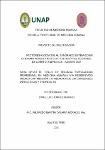| dc.contributor.advisor | Casapía Morales, Wilfredo Martín | |
| dc.contributor.author | Espinoza Venegas, Luis Alfredo | |
| dc.date.accessioned | 2022-01-31T23:23:54Z | |
| dc.date.available | 2022-01-31T23:23:54Z | |
| dc.date.issued | 2021 | |
| dc.identifier.uri | https://hdl.handle.net/20.500.12737/7700 | |
| dc.description.abstract | La estrongiloidiasis es una parasitosis cuya importancia médica radica en
la capacidad de producir una infestación fulminante en personas con
alguna inmunosupresión y que se relaciona a pobreza y que en gestantes
podría ser un factor de riesgo para morbimortalidad materno perinatal. El
estándar de oro para el diagnóstico es el cultivo en agar en placa con
carbón activado, pero también tenemos alternativas como la Técnica de
Baermann Modificado en Copa además que también se puede utilizar
serología.
Estudios sobre prevalencia general hay múltiples con resultados muy
variados según la región geográfica y la técnica utilizada, pero en cuanto
a población gestante sólo se encontró dos estudios con prevalencia de 1.6
y 3.3%.
Para esto se realizará un estudio epidemiológico de tipo descriptivo y
observacional, cuyo objetivo será determinar la prevalencia de infección
por Strongyloides en gestantes de la amazonia; para lo cual se plantea la
hipótesis de que la prevalencia es mayor del 5%. Para esto se seleccionará
una muestra de 292 gestante mayores de 17 años de los establecimientos
de salud I-3 y I-4 de la provincia de Maynas.
Se realizará la visita domiciliaria donde se llenará la ficha de recolección
de datos además de una muestra de sangre y de heces. Las muestras de
heces se analizarán con la técnica de Baermann Modificado en Copa antes
de las 2 horas de recolectada la muestra además del cultivo en placa Agar
con carbón y se determinara la serología para estrongiloides. Los análisis
estadísticos de los datos se realizarán utilizando GraphPad Software Prism
5.0 y programa SPSS 22 y se encontrará la prevalencia de estrongiloides
en gestantes. | es_PE |
| dc.description.abstract | Strongyloidiasis is a parasitosis whose medical importance lies in the ability to
produce a fulminant infestation in people with some immunosuppression and
that is related to poverty and that in pregnant women could be a risk factor for
maternal perinatal morbidity and mortality. The gold standard for diagnosis is
the agar plate culture with activated charcoal, but we also have alternatives
such as the Modified Baermann Cup Technique in addition to which serology
can also be used.
There are multiple studies on general prevalence with highly varied results
depending on the geographic region and the technique used, but in terms of
the pregnant population, only two studies were found with a prevalence of 1.6
and 3.3%.
For this, an epidemiological study of a descriptive and observational type will
be carried out, the objective of which will be to determine the prevalence of
infection by Strongyloides in pregnant women in the Amazon; for which the
hypothesis is proposed that the prevalence is greater than 5%. For this, a
sample of 292 pregnant women over 17 years of age from health facilities I-3
and I-4 in the province of Maynas will be selected.
The home visit will be made where the data collection form will be filled in as
well as a blood and stool sample. Stool samples will be analyzed with the
Modified Baermann Cup technique within 2 hours of collecting the sample in
addition to culture on a charcoal agar plate and the serology for strongyloids
will be determined. The statistical analyzes of the data will be carried out using
GraphPad Software Prism 5.0 and the SPSS 22 program and the prevalence
of strongyloids in pregnant women will be found. | en_US |
| dc.format | application/pdf | es_PE |
| dc.language.iso | spa | es_PE |
| dc.publisher | Universidad Nacional de la Amazonía Peruana | es_PE |
| dc.rights | info:eu-repo/semantics/openAccess | es_PE |
| dc.rights.uri | https://creativecommons.org/licenses/by/4.0/ | es_PE |
| dc.subject | Strongyloides | es_PE |
| dc.subject | Infección | es_PE |
| dc.subject | Prevalencia | es_PE |
| dc.subject | Embarazo | es_PE |
| dc.title | Prevalencia de infección por strongyloides en gestantes en la amazonía peruana | es_PE |
| dc.type | info:eu-repo/semantics/masterThesis | es_PE |
| thesis.degree.discipline | Segunda Especialidad Profesional de Enfermería en Enfermedades Infecciosas y Tropicales | es_PE |
| thesis.degree.grantor | Universidad Nacional de la Amazonía Peruana. Facultad de Medicina humana | es_PE |
| thesis.degree.name | Título de Segunda Especialidad Profesional de Enfermería en Enfermedades Infecciosas y Tropicales | es_PE |
| dc.subject.ocde | http://purl.org/pe-repo/ocde/ford#3.03.08 | es_PE |
| renati.author.dni | 3684928 | |
| renati.advisor.orcid | https://orcid.org/0000-0002-5972-0948 | es_PE |
| renati.advisor.dni | 5398249 | |
| renati.type | http://purl.org/pe-repo/renati/type#trabajoAcademico | es_PE |
| renati.discipline | 21039 | es_PE |
| renati.level | http://purl.org/pe-repo/renati/level#tituloSegundaEspecialidad | es_PE |
| renati.juror | Vásquez Vásquez, Javier | |
| renati.juror | Baldeón Ríos, Jorge Luis | |
| renati.juror | Ramos Rivas, Yessenia Vanessa Sherrezade | |
| dc.publisher.country | PE | es_PE |


